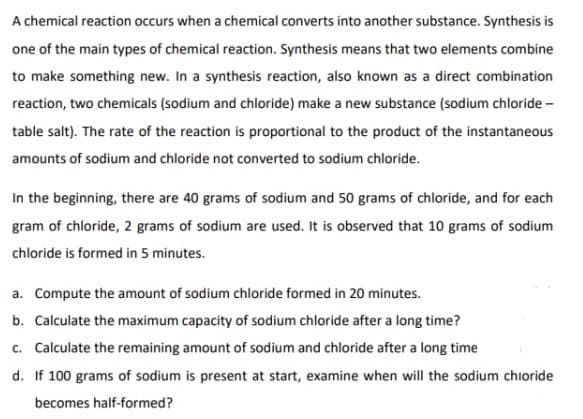A chemical reaction occurs when a chemical converts into another substance. Synthesis is one of the main types of chemical reaction. Synthesis means that two elements combine to make something new. In a synthesis reaction, also known as a direct combination reaction, two chemicals (sodium and chloride) make a new substance (sodium chloride - table salt). The rate of the reaction is proportional to the product of the instantaneous amounts of sodium and chloride not converted to sodium chloride. In the beginning, there are 40 grams of sodium and 50 grams of chloride, and for each gram of chloride, 2 grams of sodium are used. It is observed that 10 grams of sodium chloride is formed in 5 minutes. a. Compute the amount of sodium chloride formed in 20 minutes. b. Calculate the maximum capacity of sodium chloride after a long time? c. Calculate the remaining amount of sodium and chloride after a long time d. If 100 grams of sodium is present at start, examine when will the sodium chloride becomes half-formed?
A chemical reaction occurs when a chemical converts into another substance. Synthesis is one of the main types of chemical reaction. Synthesis means that two elements combine to make something new. In a synthesis reaction, also known as a direct combination reaction, two chemicals (sodium and chloride) make a new substance (sodium chloride - table salt). The rate of the reaction is proportional to the product of the instantaneous amounts of sodium and chloride not converted to sodium chloride. In the beginning, there are 40 grams of sodium and 50 grams of chloride, and for each gram of chloride, 2 grams of sodium are used. It is observed that 10 grams of sodium chloride is formed in 5 minutes. a. Compute the amount of sodium chloride formed in 20 minutes. b. Calculate the maximum capacity of sodium chloride after a long time? c. Calculate the remaining amount of sodium and chloride after a long time d. If 100 grams of sodium is present at start, examine when will the sodium chloride becomes half-formed?
Chemistry
10th Edition
ISBN:9781305957404
Author:Steven S. Zumdahl, Susan A. Zumdahl, Donald J. DeCoste
Publisher:Steven S. Zumdahl, Susan A. Zumdahl, Donald J. DeCoste
Chapter12: Chemical Kinetics
Section: Chapter Questions
Problem 96AE: Iodomethane (CH3I) is a commonly used reagent in organic chemistry. When used properly, this reagent...
Related questions
Question

Transcribed Image Text:A chemical reaction occurs when a chemical converts into another substance. Synthesis is
one of the main types of chemical reaction. Synthesis means that two elements combine
to make something new. In a synthesis reaction, also known as a direct combination
reaction, two chemicals (sodium and chloride) make a new substance (sodium chloride -
table salt). The rate of the reaction is proportional to the product of the instantaneous
amounts of sodium and chloride not converted to sodium chloride.
In the beginning, there are 40 grams of sodium and 50 grams of chloride, and for each
gram of chloride, 2 grams of sodium are used. It is observed that 10 grams of sodium
chloride is formed in 5 minutes.
a. Compute the amount of sodium chloride formed in 20 minutes.
b. Calculate the maximum capacity of sodium chloride after a long time?
c. Calculate the remaining amount of sodium and chloride after a long time
d. If 100 grams of sodium is present at start, examine when will the sodium chloride
becomes half-formed?
Expert Solution
This question has been solved!
Explore an expertly crafted, step-by-step solution for a thorough understanding of key concepts.
Step by step
Solved in 3 steps with 2 images

Knowledge Booster
Learn more about
Need a deep-dive on the concept behind this application? Look no further. Learn more about this topic, chemistry and related others by exploring similar questions and additional content below.Recommended textbooks for you

Chemistry
Chemistry
ISBN:
9781305957404
Author:
Steven S. Zumdahl, Susan A. Zumdahl, Donald J. DeCoste
Publisher:
Cengage Learning

Chemistry: An Atoms First Approach
Chemistry
ISBN:
9781305079243
Author:
Steven S. Zumdahl, Susan A. Zumdahl
Publisher:
Cengage Learning


Chemistry
Chemistry
ISBN:
9781305957404
Author:
Steven S. Zumdahl, Susan A. Zumdahl, Donald J. DeCoste
Publisher:
Cengage Learning

Chemistry: An Atoms First Approach
Chemistry
ISBN:
9781305079243
Author:
Steven S. Zumdahl, Susan A. Zumdahl
Publisher:
Cengage Learning


Chemistry for Engineering Students
Chemistry
ISBN:
9781337398909
Author:
Lawrence S. Brown, Tom Holme
Publisher:
Cengage Learning

Chemistry by OpenStax (2015-05-04)
Chemistry
ISBN:
9781938168390
Author:
Klaus Theopold, Richard H Langley, Paul Flowers, William R. Robinson, Mark Blaser
Publisher:
OpenStax

Chemical Principles in the Laboratory
Chemistry
ISBN:
9781305264434
Author:
Emil Slowinski, Wayne C. Wolsey, Robert Rossi
Publisher:
Brooks Cole